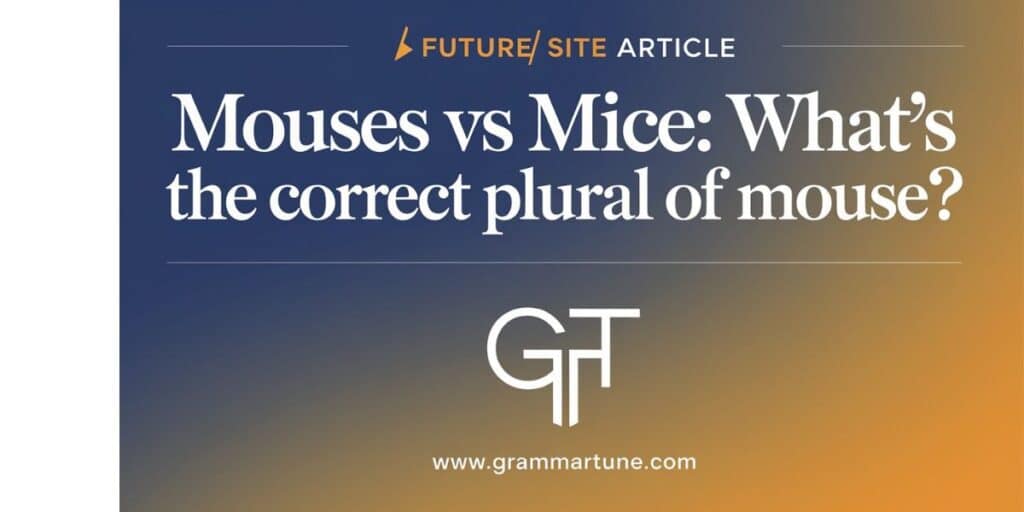The English language can be tricky, and Mouses vs Mice: What’s the Correct Plural of Mouse? is a perfect example. When talking about the small rodent, the correct plural is always mice. However, in the world of technology, things get complicated.
Some people use mouses to refer to multiple computer devices, while others stick with mice for consistency. Both terms exist, but mice is more widely accepted. Understanding this distinction helps in both casual and professional settings. Let’s explore the origins and correct usage of these words.
📑 Table of Contents
🖱️ Understanding the Plural of Mouse
1️⃣ Mouses vs Mice: What’s the Correct Plural of Mouse?
2️⃣ What Does the Word “Mouse” Mean?
3️⃣ What’s the Difference Between “Rat” and “Mouse”?
4️⃣ Plural of “Mouse” – What’s the Right Choice?
📖 Grammar, Usage, and Examples
5️⃣ Which One Should Be Used: “Mouses” or “Mice”?
6️⃣ Origins of the Word “Mouse”
7️⃣ Using “Mouse,” “Mice,” and “Mouses” in Sentences
8️⃣ Examples of “Mouse,” “Mice,” and “Mouses” in Context
What Does the Word “Mouse” Mean?
The word “mouse” refers to a small rodent with a pointed nose and long tail. It also describes a handheld device used to control a computer. In slang, “mouse” can mean a timid person. Some languages have different words for each meaning.
The term comes from Old English “mūs,” which meant the rodent. Over time, its meaning expanded to include the electronic device. Context determines how the word is interpreted.
Must read: Understanding “Princess’ or Princess’s?”
What’s the Difference Between “Rat” and “Mouse”?
“Rat” and “mouse” describe different rodents, though they share similarities. Mice are smaller, with delicate features and longer tails. Rats have larger bodies, thicker tails, and stronger teeth. They also behave differently—rats are more aggressive and adaptable.
Mice tend to be timid and curious. The words also differ in usage; “rat” can be an insult, while “mouse” often suggests shyness. Knowing these differences helps with correct word choice.
Plural of “Mouse”
The plural of “mouse” depends on its meaning. When referring to rodents, “mice” is the correct plural. For computer devices, “mouses” are sometimes used. However, many still say “mice” for both meanings.
Dictionaries accept “mouses” in tech-related contexts. Despite this, “mice” remains more common in everyday speech. Understanding this distinction ensures proper usage.
📊 Usage Table: Mouse, Mice, and Mouses
| Word | Singular/Plural | Context | Example Sentence |
| Mouse | Singular | Rodent / Computer Device | “I saw a mouse in the kitchen.” / “This mouse is wireless.” |
| Mice | Plural | Rodents / Computer Devices (Preferred) | “There are many mice in the attic.” / “I connected two mice to my laptop.” |
| Mouses | Plural | Less Common (Tech-Only) | “Some developers prefer using two mice for multitasking.” |
Which One Should Be Used: “Mouses” or “Mice”?
When talking about animals, always use “mice.” This follows standard English grammar rules. In technology, both “mice” and “mice” are used, though “mice” is more popular. Tech professionals may prefer “mouses” to avoid confusion.
However, most people still use “mice” for both meanings. Sticking with “mice” is the safest choice in most cases. The context will determine which form fits best.
Origins of the Word “Mouse”
The word “mouse” comes from Old English “mūs.” It traces back to Proto-Germanic and Indo-European roots. Ancient languages like Greek and Sanskrit have similar words. The name likely comes from the rodent’s quick, scurrying movement.
The computer “mouse” got its name due to its shape and cord resembling a tail. Language constantly evolves, adapting to new meanings. This historical background explains the world’s dual usage.
Using “Mouse,” “Mice,” and “Mouses” in Sentences
Mouse:
I saw a tiny mouse hiding under the couch.
She bought a new gaming mouse for her computer.
The cat chased the mouse around the house.
A wireless mouse makes work more convenient.
The old mouse stopped working after years of use.
That little mouse ran across the kitchen floor.
He clicked the mouse to open the file.
Mice:
There were five mice in the attic last winter.
She’s afraid of mice running around her house.
The scientist studied how mice respond to new environments.
Both my laptops have wireless mice for convenience.
Cartoons often portray mice as clever and mischievous.
The pet store sells white and gray mice.
Farmers struggle to keep mice away from crops.
Mouses:
The office bought ten new mice for employees.
Some tech experts insist on using mice instead of “mice.”
Different brands make ergonomic mouses for comfort.
Gaming mouses come with extra buttons for shortcuts.
A store selling computer accessories stocks various mouses.
Wireless mouses are more convenient than wired ones.
Many people still say “mice” instead of mice in tech.
Definition and Plural of Computer Mouse
A computer mouse is a handheld device used to control a cursor on a screen. It allows users to click, scroll, and navigate software with ease. The plural of computer mouse is debated, with both “mice” and “mouses” being used.
Most people say “mice” to match the plural of the rodent. However, “mouses” is sometimes used in technical settings. While dictionaries recognize both, “mice” remains more common. The preferred term depends on the context and audience.
Using Computer Mouse and Plural of Computer Mouse
Many workplaces provide employees with a computer mouse for efficiency. Some offices stock multiple computer mice or mice for replacements. Gamers prefer specialized computer mice with customizable buttons.
Teachers explain to students how to properly use a computer mouse. Tech professionals may use “mouses” to avoid confusion with rodents. Both terms appear in manuals and discussions. Understanding the variations helps in professional and casual conversations.
Examples of Computer Mouse and Plural of Computer Mouse in Sentences
- She bought a new computer mouse for her laptop.
- The IT department ordered ten computer mice for the office.
- Some brands design ergonomic computer mouses for comfort.
- A wireless computer mouse eliminates the need for a cable.
- Different computer mice have unique sensitivity settings.
- Programmers rely on high-performance computer mouses for precision.
- His old computer mouse stopped working, so he bought a new one.
Plural Noun Rules For Regular Nouns
Most regular nouns follow simple pluralization rules. Adding -s is the most common method, as in “cat” to “cats.” Words ending in -ch, -sh, -x, -s, or -z require -es instead, like “box” to “boxes.”
If a noun ends in a consonant followed by -y, the -y changes to -ies (e.g., “baby” to “babies”). However, if the -y follows a vowel, simply add -s (e.g., “key” to “keys”). These rules cover most English nouns.
Plural Noun Rules For Irregular Nouns
Irregular nouns do not follow standard pluralization patterns. Some change vowels, like “man” to “men” and “tooth” to “teeth.” Others remain the same, such as “sheep” and “deer.” A few take on entirely new forms, like “child” to “children.”
Many irregular plurals originate from Old English or Latin. Learning them requires memorization rather than a simple rule. They add complexity to the language but make English unique.
List of Common Irregular Plural Nouns
Some irregular plural nouns are frequently used in daily life. Here are a few examples:
- Man → Men
- Woman → Women
- Child → Children
- Foot → Feet
- Tooth → Teeth
- Person → People
- Mouse → Mice
Knowing these helps with both speaking and writing accurately.
Nouns That End in ‘Us’
Many Latin-based nouns ending in -us form plurals by changing to -i. For example, “cactus” becomes “cacti,” and “focus” changes to “foci.” However, some words have two acceptable plurals. “Octopus” can be either “octopi” or “octopuses.”
Scientific and academic fields often prefer the classical Latin plural. However, casual usage may favor the -es ending. Understanding context helps in choosing the right form.
Nouns That End in ‘Is’
Nouns ending in -is typically change to -es in their plural form. For example, “analysis” becomes “analyses,” and “crisis” turns into “crises.” These words come from Greek origins, which influence their pluralization.
The spelling shift reflects pronunciation changes as well. These irregular plurals are common in academic and scientific writing. Learning them helps in professional communication.
You will like: Community’s, Communities’, or Communities? A Simplified Guide
Nouns That End in ‘On’ and ‘Um’
Some Latin-based nouns ending in -on or -um change to -a in plural form. “Phenomenon” becomes “phenomena,” while “datum” turns into “data.” However, certain words, like “stadium,” have both “stadiums” and “stadia” as acceptable plurals.
In modern English, “data” is often treated as singular. These forms are most common in scientific, mathematical, and technical contexts.
Plurals That Are the Same as Singulars
Some words do not change between singular and plural forms. Examples include “sheep,” “deer,” and “moose.” These nouns are called zero plurals, meaning their plural form matches the singular.
This occurs mostly with animals and measurement units. For instance, “one fish” and “two fish” remain unchanged. Learning these exceptions prevents common grammar mistakes.
Words That Look Like Plural Nouns But Are Singular Nouns
Some singular nouns appear plural due to their -s ending. Words like “news,” “mathematics,” and “physics” seem plural but are actually singular. They often refer to collective ideas rather than countable objects.
Other examples include “measles” and “politics.” These words take singular verbs despite their misleading appearance. Recognizing them improves writing clarity.
Plural Nouns vs. Possessive Nouns
Understanding plural nouns and possessive nouns helps avoid common grammar mistakes. Plural nouns indicate more than one of something, like “dogs” or “cars.” Possessive nouns show ownership, as in “the dog’s bone” or “the car’s engine.”
The difference lies in the apostrophe—plural nouns don’t need one, but possessive nouns do. Many people confuse them, especially with words ending in -s. Learning their correct usage improves both writing and speaking.
Plural Nouns
A plural noun represents more than one person, place, or thing. Most plurals simply add -s or -es, like “books” or “boxes.” However, some words change spelling, such as “child” to “children.”
Others remain the same, like “deer” and “sheep.” Knowing these rules ensures correct communication. English learners often struggle with irregular plurals. Practicing different forms helps with mastery.
Possessive Nouns
A possessive noun shows that something belongs to someone or something. Singular nouns add ‘s, like “the cat’s toy.” Plural possessives usually place the apostrophe after -s, as in “the dogs’ owner.”
However, irregular plurals like “children” use ‘s, making it “the children’s books.” Many people forget where to place the apostrophe. Understanding this rule makes writing clearer.
Common Mistakes with Plural Nouns
Many people mistakenly add apostrophes to plural nouns, writing “apple’s” instead of “apples.” Another mistake is forgetting irregular plural forms, like using “mooses” instead of “moose.”
Some nouns, like “datum” and “data,” confuse people because their plurals sound singular. Uncountable nouns, such as “furniture,” should not have plural forms. Learning these common errors prevents awkward sentences. Reviewing grammar rules improves accuracy.
Irregular Plurals
Not all words follow the simple -s or -es rule for pluralization. Some change vowels, like “man” to “men” and “tooth” to “teeth.” Others take Latin or Greek endings, such as “crisis” to “crises.”
A few words, like “sheep” and “deer,” don’t change at all. Irregular plurals must be memorized rather than following a pattern. These exceptions make English more complex but also more interesting.
You will like: Long Term or Long-Term: What’s the Right Choice in Writing?
Countable vs. Uncountable Nouns
A countable noun can be pluralized, such as “apple” to “apples.” An uncountable noun, like “water” or “rice,” doesn’t have a standard plural form. Instead, we use measurements like “a glass of water” or “a bowl of rice.”
Many uncountable nouns refer to substances, concepts, or abstract ideas. Some words, like “hair,” can be both countable and uncountable depending on context. Understanding the difference helps with proper word choice.
Collective Nouns
A collective noun refers to a group acting as a single unit. Examples include “team,” “family,” and “audience.” In American English, collective nouns usually take singular verbs, like “The team is winning.”
However, in British English, they often take plural verbs, as in “The team are winning.” Some collective nouns, like “police,” are always plural. Learning how they function improves grammar accuracy.
FAQ’S
What is the difference between plural and possessive nouns?
Plural nouns show more than one, while possessive nouns indicate ownership with an apostrophe.
How do you form regular plural nouns?
Most add -s or -es, like “cats” and “buses,” but some change spelling, like “baby” to “babies.”
What are irregular plural nouns?
These don’t follow standard rules, such as “man” to “men” or “mouse” to “mice.”
Can uncountable nouns be pluralized?
No, they don’t have standard plural forms, but you can use measurements like “a cup of sugar.”
What is a collective noun?
It represents a group, like “team” or “family,” and usually takes a singular verb in American English.
How do you make a plural noun possessive?
For regular plurals, just add an apostrophe after -s (e.g., “dogs’ toys”), but for irregular ones, add ‘s (“children’s books”).
Why do some words look plural but are singular?
Words like “news” and “mathematics” end in -s but refer to a single concept.
Conclusion
The debate over “mouses vs. mice: what’s the correct plural of mouse?” depends on context. When referring to the small rodent, “mice” is the universally accepted plural. However, in technology, both “mice” and “mice” are used, though “mice” remains more popular. Some technical professionals prefer “mouses” to avoid confusion with animals.
While both are recognized, “mice” dominates in casual and formal speech. Understanding the distinction ensures clarity in writing and conversation. Ultimately, the correct choice depends on the audience and context.

Joulia, a seasoned wordsmith and grammar enthusiast, brings over a decade of blogging expertise to Grammar Tune. With a keen eye for linguistic precision and a passion for making complex grammar concepts accessible, he has helped thousands of readers enhance their writing skills. His engaging teaching style and practical approach to language learning have made him a trusted voice in the online grammar community.







